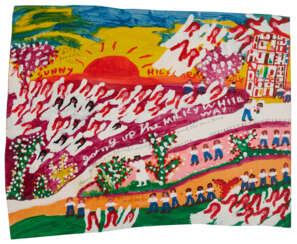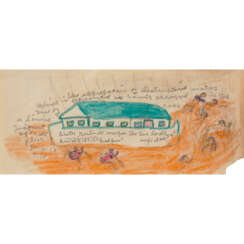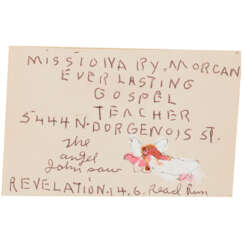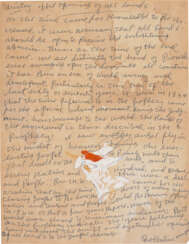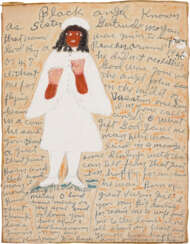Gertrude Morgan (1900 - 1980) — Auction price
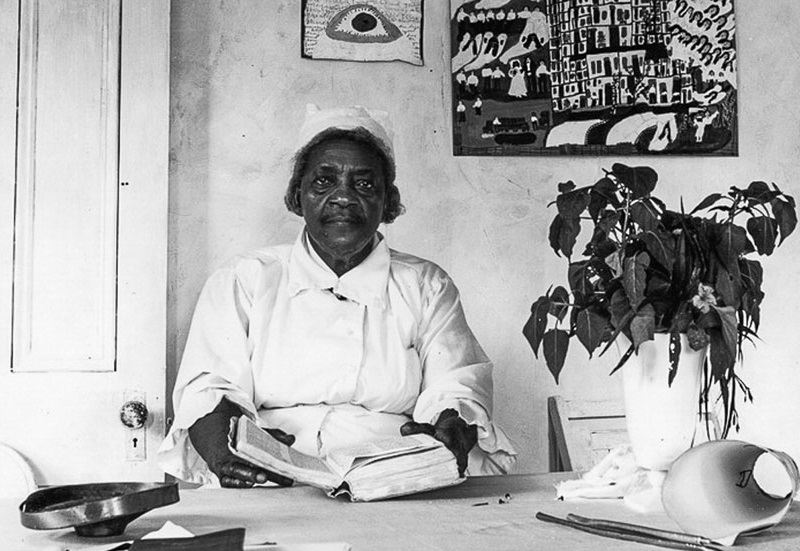
Sister Gertrude Morgan was a self-taught African-American artist, musician, poet and preacher. Sister Morgan achieved critical acclaim during her lifetime for her folk art paintings. Her work has been included in many groundbreaking exhibitions of visionary and folk art from the 1970s onwards.
Similar to other self-taught artists, Sister Morgan used simple forms to depict the human figure. Her works are characterized by their lack of the use of formal techniques such as perspective and definition of light and shadow, giving them a flat, two dimensional quality. She painted and drew using acrylics, tempera, ballpoint pen, watercolors, crayon, colored and lead pencils and felt tip markers. Using inexpensive materials she had at hand, Sister Morgan painted on paper, toilet rolls, plastic pitchers, paper megaphones, scrap wood, lampshades, paper fans and styrofoam trays. The fact that she was self-taught, coupled with her choice of materials as well as her style and subject matter have led her to be characterized as a naive, folk, visionary, vernacular and outsider artist.
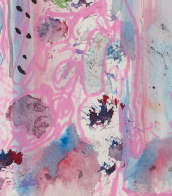

Sister Gertrude Morgan was a self-taught African-American artist, musician, poet and preacher. Sister Morgan achieved critical acclaim during her lifetime for her folk art paintings. Her work has been included in many groundbreaking exhibitions of visionary and folk art from the 1970s onwards.
Similar to other self-taught artists, Sister Morgan used simple forms to depict the human figure. Her works are characterized by their lack of the use of formal techniques such as perspective and definition of light and shadow, giving them a flat, two dimensional quality. She painted and drew using acrylics, tempera, ballpoint pen, watercolors, crayon, colored and lead pencils and felt tip markers. Using inexpensive materials she had at hand, Sister Morgan painted on paper, toilet rolls, plastic pitchers, paper megaphones, scrap wood, lampshades, paper fans and styrofoam trays. The fact that she was self-taught, coupled with her choice of materials as well as her style and subject matter have led her to be characterized as a naive, folk, visionary, vernacular and outsider artist.


Sister Gertrude Morgan was a self-taught African-American artist, musician, poet and preacher. Sister Morgan achieved critical acclaim during her lifetime for her folk art paintings. Her work has been included in many groundbreaking exhibitions of visionary and folk art from the 1970s onwards.
Similar to other self-taught artists, Sister Morgan used simple forms to depict the human figure. Her works are characterized by their lack of the use of formal techniques such as perspective and definition of light and shadow, giving them a flat, two dimensional quality. She painted and drew using acrylics, tempera, ballpoint pen, watercolors, crayon, colored and lead pencils and felt tip markers. Using inexpensive materials she had at hand, Sister Morgan painted on paper, toilet rolls, plastic pitchers, paper megaphones, scrap wood, lampshades, paper fans and styrofoam trays. The fact that she was self-taught, coupled with her choice of materials as well as her style and subject matter have led her to be characterized as a naive, folk, visionary, vernacular and outsider artist.
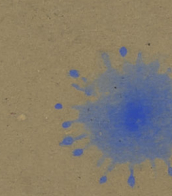

Sister Gertrude Morgan was a self-taught African-American artist, musician, poet and preacher. Sister Morgan achieved critical acclaim during her lifetime for her folk art paintings. Her work has been included in many groundbreaking exhibitions of visionary and folk art from the 1970s onwards.
Similar to other self-taught artists, Sister Morgan used simple forms to depict the human figure. Her works are characterized by their lack of the use of formal techniques such as perspective and definition of light and shadow, giving them a flat, two dimensional quality. She painted and drew using acrylics, tempera, ballpoint pen, watercolors, crayon, colored and lead pencils and felt tip markers. Using inexpensive materials she had at hand, Sister Morgan painted on paper, toilet rolls, plastic pitchers, paper megaphones, scrap wood, lampshades, paper fans and styrofoam trays. The fact that she was self-taught, coupled with her choice of materials as well as her style and subject matter have led her to be characterized as a naive, folk, visionary, vernacular and outsider artist.


Sister Gertrude Morgan was a self-taught African-American artist, musician, poet and preacher. Sister Morgan achieved critical acclaim during her lifetime for her folk art paintings. Her work has been included in many groundbreaking exhibitions of visionary and folk art from the 1970s onwards.
Similar to other self-taught artists, Sister Morgan used simple forms to depict the human figure. Her works are characterized by their lack of the use of formal techniques such as perspective and definition of light and shadow, giving them a flat, two dimensional quality. She painted and drew using acrylics, tempera, ballpoint pen, watercolors, crayon, colored and lead pencils and felt tip markers. Using inexpensive materials she had at hand, Sister Morgan painted on paper, toilet rolls, plastic pitchers, paper megaphones, scrap wood, lampshades, paper fans and styrofoam trays. The fact that she was self-taught, coupled with her choice of materials as well as her style and subject matter have led her to be characterized as a naive, folk, visionary, vernacular and outsider artist.


Sister Gertrude Morgan was a self-taught African-American artist, musician, poet and preacher. Sister Morgan achieved critical acclaim during her lifetime for her folk art paintings. Her work has been included in many groundbreaking exhibitions of visionary and folk art from the 1970s onwards.
Similar to other self-taught artists, Sister Morgan used simple forms to depict the human figure. Her works are characterized by their lack of the use of formal techniques such as perspective and definition of light and shadow, giving them a flat, two dimensional quality. She painted and drew using acrylics, tempera, ballpoint pen, watercolors, crayon, colored and lead pencils and felt tip markers. Using inexpensive materials she had at hand, Sister Morgan painted on paper, toilet rolls, plastic pitchers, paper megaphones, scrap wood, lampshades, paper fans and styrofoam trays. The fact that she was self-taught, coupled with her choice of materials as well as her style and subject matter have led her to be characterized as a naive, folk, visionary, vernacular and outsider artist.


Sister Gertrude Morgan was a self-taught African-American artist, musician, poet and preacher. Sister Morgan achieved critical acclaim during her lifetime for her folk art paintings. Her work has been included in many groundbreaking exhibitions of visionary and folk art from the 1970s onwards.
Similar to other self-taught artists, Sister Morgan used simple forms to depict the human figure. Her works are characterized by their lack of the use of formal techniques such as perspective and definition of light and shadow, giving them a flat, two dimensional quality. She painted and drew using acrylics, tempera, ballpoint pen, watercolors, crayon, colored and lead pencils and felt tip markers. Using inexpensive materials she had at hand, Sister Morgan painted on paper, toilet rolls, plastic pitchers, paper megaphones, scrap wood, lampshades, paper fans and styrofoam trays. The fact that she was self-taught, coupled with her choice of materials as well as her style and subject matter have led her to be characterized as a naive, folk, visionary, vernacular and outsider artist.


Sister Gertrude Morgan was a self-taught African-American artist, musician, poet and preacher. Sister Morgan achieved critical acclaim during her lifetime for her folk art paintings. Her work has been included in many groundbreaking exhibitions of visionary and folk art from the 1970s onwards.
Similar to other self-taught artists, Sister Morgan used simple forms to depict the human figure. Her works are characterized by their lack of the use of formal techniques such as perspective and definition of light and shadow, giving them a flat, two dimensional quality. She painted and drew using acrylics, tempera, ballpoint pen, watercolors, crayon, colored and lead pencils and felt tip markers. Using inexpensive materials she had at hand, Sister Morgan painted on paper, toilet rolls, plastic pitchers, paper megaphones, scrap wood, lampshades, paper fans and styrofoam trays. The fact that she was self-taught, coupled with her choice of materials as well as her style and subject matter have led her to be characterized as a naive, folk, visionary, vernacular and outsider artist.


Sister Gertrude Morgan was a self-taught African-American artist, musician, poet and preacher. Sister Morgan achieved critical acclaim during her lifetime for her folk art paintings. Her work has been included in many groundbreaking exhibitions of visionary and folk art from the 1970s onwards.
Similar to other self-taught artists, Sister Morgan used simple forms to depict the human figure. Her works are characterized by their lack of the use of formal techniques such as perspective and definition of light and shadow, giving them a flat, two dimensional quality. She painted and drew using acrylics, tempera, ballpoint pen, watercolors, crayon, colored and lead pencils and felt tip markers. Using inexpensive materials she had at hand, Sister Morgan painted on paper, toilet rolls, plastic pitchers, paper megaphones, scrap wood, lampshades, paper fans and styrofoam trays. The fact that she was self-taught, coupled with her choice of materials as well as her style and subject matter have led her to be characterized as a naive, folk, visionary, vernacular and outsider artist.



